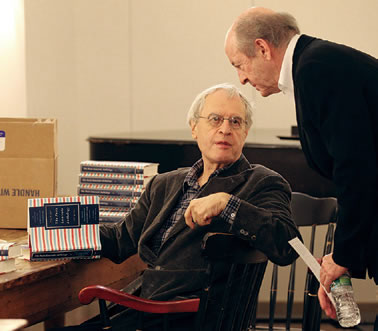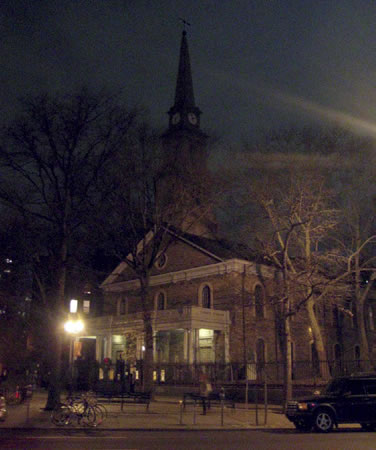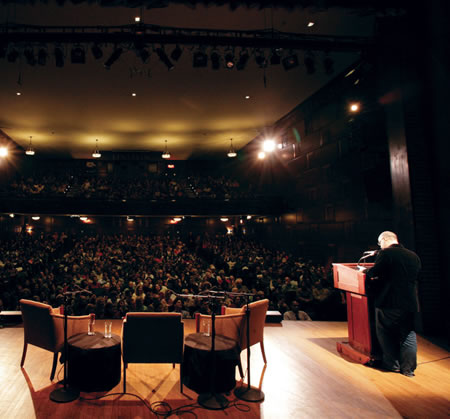The Unlonely Poet

Poets House in Battery Park is a national poetry library and literary center dedicated to the living tradition of poetry. Photo by Mark Woods
In his classic essay, "Here Is New York," E. B. White explains: "A poem compresses much in a small place and adds music, thus heightening its meaning…. The island of Manhattan is without any doubt the greatest human concentrate on earth, the poem whose magic is comprehensible to millions of permanent residents but whose full meaning will always remain elusive." That the city’s song is inexhaustible is good news for new generations of poets who keep coming to New York, but how does the poet survive in the city?
Fortunately, poets and lovers of poetry have been solving this riddle for years. Lee Briccetti, executive director of Poets House, described her organization's beginnings. Before its founding in 1985, Stanley Kunitz, two-time U.S. Poet Laureate, and Elizabeth Kray, visionary arts administrator, started talking about ways to encourage writers and readers of poetry. "There was a feeling that poets were very lonely in our culture, so initially Poet's House was designed to provide nurture for poets and a home where there could be friendship and affiliation and learning. At the same time, [they wanted] a place that would invite the general public to have a different experience of poetry, to encounter it with more pleasure and understanding."

Poets Charles Simic (l) and Billy Collins at the Poetry Society of America centennial event, One Hundred Years of American Poetry: 1910-2010. Photo by Lawrence Schwartzwald |
Clearly the scheme has succeeded. About to celebrate its 25th anniversary, Poet’s House is an ever-expanding organization with more than 200 programs each year, a library with 50,000 volumes of poetry, and the annual Poets House Showcase, an exhibit of all the year's published poetry books. "There is nowhere else in the country where you can see all the books in one place," Briccetti noted. "We are a place. That's the thing that makes us different from a lot of other presenters."
Stephen Motika, the program director, emphasized the significance of place as well. "There is this space for people to come in and interact with poetry. The whole collection is a reading room. It's a refuge." And with its immensely successful Poetry in the Branches program, Poets House has extended its reach far beyond its new home in Battery Park City by fostering audiences in local communities nationwide. One current iteration of the program, the Language of Conservation, has poets-in-residence collaborating with biologists at five zoos and four public libraries to explore the connections between poetry, environmental awareness, and conservation. Some of the work generated through this project is permanently installed in the exhibits, inviting visitors to these institutions to think more deeply about what they encounter.

St. Mark's Church hosts the Poetry Project, which presents readings, workshops, and various special events related to poetry. Photo by Star Black |
A frequent collaborator with Poets House, the Poetry Society of America (PSA) has been "putting poetry at the crossroads of American life" for 100 years, making it the oldest poetry organization in the country. Currently celebrating its centennial anniversary, the PSA presents almost 60 programs a year, both in New York and nationwide. In addition to highly visible initiatives such as Poetry in Motion and Poem in Your Pocket, the PSA also sponsors the New Salon at New York University and Queens College, a series of conversations and readings intended to inspire a younger audience. In 2008, the PSA co-hosted State of the Art: African American Poetry Today, a two-day festival of lectures and readings at Boston University's Howard Gottlieb Archival Research Center. Cosponsored by the Boston Review and the not-for-profit Cave Canem, the two-day festival was attended by more than 2,000 people.
The PSA also supports poetry communities in Minneapolis, Atlanta, Boston, Los Angeles, and Washington, DC. "For the PSA it means diving into these various places and bringing a national organization to lift up the local scene and to show that it really matters to the country to have these major enthusiastic audiences for the art," said PSA Executive Director Alice Quinn. "In a couple of years I hope we’ll have another five." Addressing the question of how arts organizations create community, Quinn continued, "The biggest problem in poetry has always been 'how does the audience find the poetry that they are bound to love?' And it's all about relying on wonderful teachers and local arts organizations to care about the art and to expose people to it. It’s a big streambed and you’ve got to keep the water flowing."

Author Junot Diaz reads at the 92nd Street Y. Courtesy of the 92nd Street Y |
Two other loci of New York's poetry community are the Poetry Project at St. Mark's Church and the Unterberg Poetry Center at the 92nd Street Y. Located in the East Village, the Poetry Project presents three reading series each week, six to eight workshops per year, a newsletter, a journal, an online archive, and various special events, including the beloved New Year’s Day Marathon Reading. Since its inception in the 1960s, the Poetry Project has prided itself on being an organization run by poets. Artistic Director Stacy Szymaszek explained, "This is very intentional and comes out of a belief that the people who run an organization for poets need to know what it is to be a poet in our society, the set of rewards and problems that come with the investment in life as a poet." Whereas the PSA is a national institution reaching out to the broadest possible audience, the Poetry Project is decidedly more local.
"I think the Project has maintained an important aspect of its grassroots beginnings in the realm of the social—the reading as a social gathering," added Szymaszek. "A kid who has been turned on by the work of John Godfrey or Bruce Andrews can come to New YorkCity, attend a reading, and find themselves out to dinner or at a bar with them afterward."
Across town, on the Upper East Side, the Unterberg Poetry Center at the 92nd Street Y has been an important part of the city’s literary landscape since 1939. William Carlos Williams was the first poet to read from the podium, and for the last 70 years, the reading series has attracted distinguished writers of all genres, including Dylan Thomas, Langston Hughes, Marianne Moore, Octavio Paz, and Maxine Hong Kingston. The writing program has existed since the Poetry Center's beginning, and it continues to offer workshops at every level from introductory through master classes taught by poets who appear in the reading series. A literary magazine, Podium, features the work of writers selected by their fellow students or their teachers, and each semester culminates in a public reading.
Director Bernard Schwartz explained that the mission of the Poetry Center is "to honor the voice of literature. To create a place where people can come and listen to writers read their work, a place where close attention is expected and rewarded." One reading series run by the Poetry Center is The Tenth Muse, which allows an established poet to curate an evening of emerging talent. Another current project is the Virtual Poetry Center, an online archive of digitized audio recordings dating back to the early 1940s. "We are bringing real treasures from our archives to a position that they can be enjoyed by the public," said Schwartz. "A long term goal is finding a way to really connect with teachers all across the country, and because of the Internet your ambition can be really limitless with regards to geography."
As Alice Quinn confidently stated, "We know that poetry is popular"—it’s a matter of finding a way to share the art form with the community. And the work of these organizations demonstrates that poetry is alive and well in the streets where the likes of Allen Ginsberg, Hart Crane, Frank O'Hara, Langston Hughes, and Edna St. Vincent Millay once walked.








